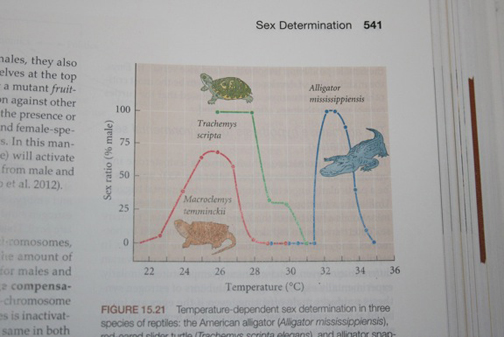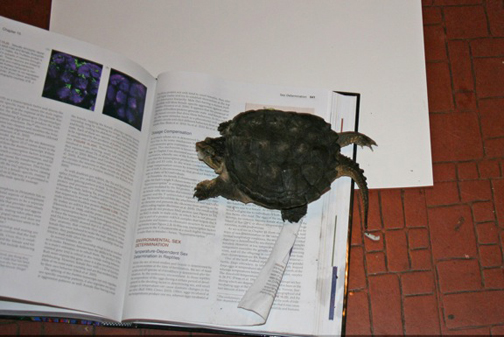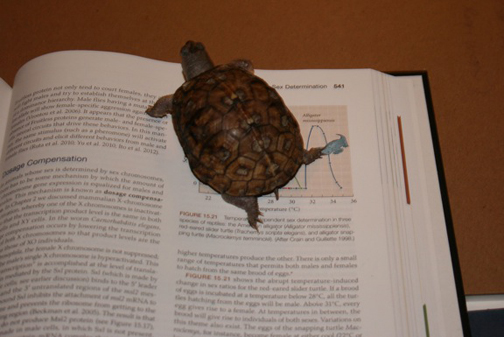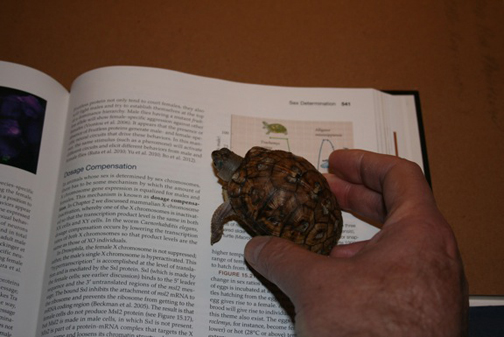Sex Determination
The mechanisms that control whether a given animal will develop into a male or develop into a female, or in some kinds of animal into a hermaphrodite.Very different mechanisms: for examples, turtles & alligators

from Scott Gilbert's textbook



Lower temperature --> More males
Higher temperature---> More females; increase effectiveness of aromatase gene
Aromatase converts the first ring of the testosterone into a benzene-like ring
Aromatase is also used & studied in relation to gender related cancers.
------------------------------------------------------------------------------------------------------
Even the apparent XX XY systems in mammals and flies are utterly different at the molecular level.
One difference is sex hormones: Flies don't use sex hormones; instead each fly cell develops its sexual properties based on X chromosomes (if 2 then female; if 1 then male)
The fly Y chromosome carries genes that are needed for fertility, but not necessary for most of male development. This is in contrast to mammals, whose Y chromosome carries the SRY gene which directly causes development as male Therefore: an X0 fly is a sterile male - but an X0 mammal is a sterile female
------------------------------------------------------------------------------------------------------
In vertebrates, the same piece of tissue (genital ridge) differentiates into either testis of ovary.
Primordial germ cells aggregate there, guided by an unknown mechanism
(I bet wnt will have something to with it)
Many species of fish normally switch from being one sex to being the other.
Many start as males and convert to females ("protandrous" male-first)
Some start as females, and convert to become males,
in some species in response to lack or loss of males in a locality.
------------------------------------------------------------------------------------------------------
The sex ducts develop from entirely different tissues:
Male sex duct was the embryonic sperm duct.
Mesonephric duct = pronephric duct = Woflfian duct --> vas deferens
(epididymis develops from mesonephric kidney ducts)
[note all from intermediate mesoderm]
Female sex duct develops from lateral plate mesoderm
Müllerian duct --> Oviduct fallopian tubule, uterus Müullerian duct develops in both sexes, but is stimulated to self-destruct by "anti-Müllerian duct hormone"
The Wolffian duct degenerates in females.
In other words, sperm & egg ducts are not homologous; they develop from completely different tissues (female-lateral plate; male intermediate mesoderm
Vertebrates of both sexes form both sperm and egg ducts: & then destroy the one they don't need.
------------------------------------------------------------------------------------------------------
But notice that testis and ovary develop from the same tissue: genital ridge of lateral plate mesoderm;
Specifically in male mammals, the testis gets physically pulled posterior from the middle of the back (where the ovaries remain) down to the groin. Supposedly, this is because body temperature interferes with sperm development, so the testes need to be kept cool.
The other warm blooded vertebrate, birds, keep their testes at their original location; and have an air duct next to them, for air-conditioning by air from the lungs.
This has been a controversial issue:
------------------------------------------------------------------------------------------------------
Incidentally, it is unusual for a completed organ to be moved from one part of the body to another.
(Sort of like moving a house)
Although long distance movements of cells is not at all unusual.
Another example, close to the path along which the testes are pulled rearward,
the metanephros kidneys are moved forward from the groin area up into the
lower back, at about belt-level.
The ureter (metanephric duct) gets looped around the vas deferens
------------------------------------------------------------------------------------------------------
The internal histological structure of gonads.
Testis becomes spaghetti-like, seminiferous tubules.
Ovary becomes more like a solid raisin pudding;
with only a few thousand large oocytes scattered through solid masses of special
hormone secreting cells.
Another difference is that oocytes and ovary structure (and even meiosis)
begin developing during embryonic development of female vertebrate embryos.
But sperm don't begin to develop until puberty.
NOTE: This is important to the immune system.
------------------------------------------------------------------------------------------------------
Discovered by Prof. Bruce Baker, who used to be a professor in this department,
but made these discoveries after he moved to California.
Earlier scientists had already discovered the genes whose mRNAs get spliced into either male-forming or female-forming alternatives - "doublesex gene"
Every girl or woman is a genetic mosaic of irregular milimeter or centimeter-sized volumes of their tissues which express the genes from just one (or just the other) of her X chromosomes.
Sex linked genes (for example, color blindness, should produce their phenotype in half of these bits of tissue.
------------------------------------------------------------------------------------------------------
Each (normal) sperm cell contains a complete set of autosomes, plus either one X chromosome or one Y chromosome.
All normal egg cells (in mammals) contain a set of autosomes and an X chromosome.
If an egg cell gets fertilized by one of the Y containing sperm, then that embryo will develop into a male. Conversely, females develop from eggs that got fertilized by one of the X containing sperm.
Half the sperm contain X chromosomes and the other half contain Y chromosomes, so you would expect the the sex ratio to be exactly 50-50. But that ratio depends on the two kinds of sperm having equal probabilities of "success" in reaching the upper end of the Fallopian tubules and fertilizing an egg. The actual human sex ratio is slightly different: more like 51% to 49%, with a percent or so more males being born. This could result from the "male" sperm swimming faster, or any number of small differences. The death rate for male humans is significantly higher, from before birth onward.
Evolutionary biologists argue that selection should tend to make our sex ratios 50-50 at the ages when reproduction occurs; from which it follows that higher death rates in males would tend to cause evolution of mechanisms to distort the sex ratio at birth in favor of males.
Several common pollutants tend to convert developing males into (abnormal!) females, at least in many animals. Such chemicals include PCBs and "atrazine" which is the most heavily used herbicide in the world. They may also reduce the fertility of human males. Not nearly enough is being done either to reduce these dangers or to continue research about them.
------------------------------------------------------------------------------------------------------
Steroid sex hormones are also part of the control of how the embryonic body develops. In many species, the morphology of a developing embryo can be forced to develop into the opposite sex, by injecting large enough quantities of steroid sex hormones. But they may not be anatomically normal in the development of their gonads and sex ducts.
Similarly, a certain genetic abnormality occurs in some human males, who have mutations in the genes that code for the receptor proteins that bind to male sex hormones. The cells of their bodies are therefore unable to detect the male steroid sex hormones being secreted by their testes, but their cells can detect the smaller amounts of female steroid sex hormones that are produced in both sexes. So these male humans look like women, externally, and usually grow up thinking they are women. But they have testes where their ovaries should be; and their sex ducts are also male-like. This is called androgen insensitivity syndrome.
In some fish, multiple sex chromosomes have been reported (with more than two kinds)
Platypus has ten sex chromosomes! We learn something new every day!!
------------------------------------------------------------------------------------------------------
The taxonomic group of insects called Hymenoptera control sex in yet a different way: fertilized eggs develop into females (with two sets of chromosomes = "diploid"), and eggs that are not fertilized (and are therefore haploid ) develop into males .
Among other consequences, this results in sisters inheriting 75% the same genes, instead of 50% as in human siblings. It had long been a puzzle why three of the four groups of "social insects" are hymenoptera (i.e. ants, wasps and bees, and NOT termites which belong to a different group).
Scientists tried to think of reasons why the business of living in colonies, having a "Queen", and all that, should have evolved so often in this one particular group of insects.
When I was a senior in college, I wrote a term paper about this issue, and invented some theories of my own. That was the same year that W. D. Hamilton became famous by inventing what is certain to be the true explanation, which is that evolution of altruistic behaviors is favored in proportion to what fraction of genes are "shared" among populations. This insight stimulated the creation of what is nearly a whole new branch of biology, called "Sociobiology", which looks for patterns in the evolution of instinctive behaviors of animal interaction.
By what experiment could you conclusively prove that testes move the groin to keep cool?
Millions of sperm develop on the inner walls of these tubules.
Supported and nourished by a special cell type : Sertoli CellsDosage compensation in flies
Alternative types of RNA splicing are the key events in sex determination of flies.
Both X chromosome in a female fly are transcribed at normal, low rate.
The single X in a male fly is transcribed into twice as much RNA as do Xs in female flies. Dosage compensation in mammals
All but one X chromosome supresses almost all its RNA synthesis
(Normally one of two Xs; but females with 3 Xs are viable)